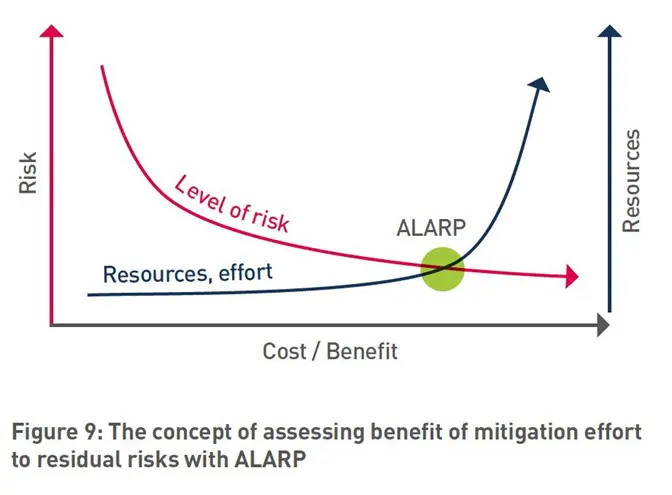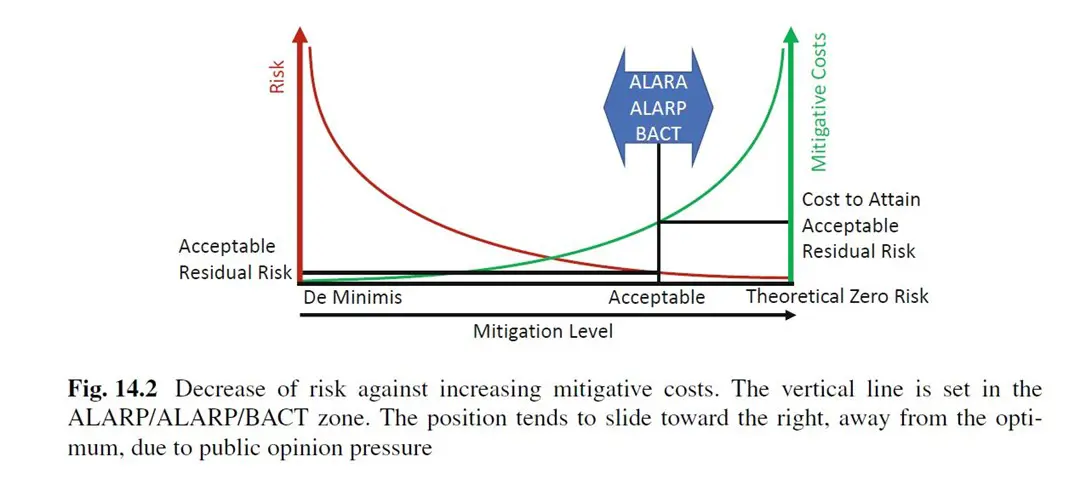In our mind, showing the ALARP value as a range and not as a theoretical dot helps convey the idea that tailings systems are complex and surrounded by uncertainties.
A Glossary is Important and Should be Robust
Back to reading the ICMM Guidance and Conformance protocols, it would have been preferable if they had defined and quantified the term “tolerance.” Delivering a quantitative risk tolerance threshold is part of our day-to-day practice for the mining industry. It brings significant value to tactical and strategic planning of mitigation applied to a portfolio of systems.
Terms like “negligible likelihood” should also be better explained to avoid blunders and preposterous statements. In addition, more clarity on this term would enhance consistency in the conformance by different companies and different engineers of record. Egregious examples of possible confusion and resulting crises appear on a regular basis in the media.
For instance, an assessment of the probability of failure of a hydro dam in the US reportedly delivered a value of 1 in a billion in any given year. How an assessment may have come to that value was not described, but that value is blatantly invalid as it is far below usually accepted credibility threshold, 1,000 times lower than the credibility threshold and hydro dams benchmarking (Table 4) which corresponds to values we derived in a prior blogpost on an Indian dam break and way lower than the performance of a regulated industry (such as nuclear).
A later assessment of the same dam reportedly delivered a higher value: 1.5-in-10,000 chance of a dam failure. This last value is in line with “normal hydro dams,” but the jump upward reportedly created a crisis situation. In the present state, we think that this type of crisis may arise with tailings dams unless the ICMM documents become more prescriptive and clearer on the objectives and terminology.
Selected ICMM Conformance Requirements Discussion
Risk-informed Decision-making
Requirement 4.7 clearly states the need for risk-informed decision-making for existing structures. Additionally, it requires reaching an ALARP level. To ensure repeatability and transparency, we consider this is feasible only with a quantitative risk assessment (QRA) approach. Fortunately, this is one of the two possible means considered by the ICMM document. Indeed, the other alternative, i.e. a semi-quantitative failure modes and effects analysis (FMEA) (see Requirement 5.4, note 1) does not offer the same level of resolution, repeatability and transparency. Furthermore, especially for owners of large portfolios, semi-quantitative FMEA would lead to paralysis by analysis, incur excessive costs and deter users from making regular updates.
Reducing Probability and Consequences of Failures
Requirement 4.7 also asks for approval and documentation of measures to reduce both the probability and the consequences of a tailings facility failure. These actions aim to reduce risk to an ALARP level. Conformance will require risk-informed basis and timing for addressing the upgrade of existing tailings facilities. In addition, conformance requires carrying out actions as soon as reasonably practical, indicating the need for a risk-based prioritization of these actions.
Using Appropriate Methods to Reach the ICMM Goals
As stated above, a FMEA will not provide a granular enough probability of failure and a swift comparison to the ALARP target. This is one of the reasons we developed ORE2 Tailings™. ORE2_Tailings anticipated the ICMM requirements as it covers these angles and more. For instance, it includes the evaluation of the impact of standard of care on a given system. Furthermore, ORE2_Tailings delivers the probability of failure of the dam system and benchmarks it to the worldwide tailings dam portfolio performance.
Dam System Knowledge Base and Results Completeness
ORE2_Tailings accommodates uncertainties generated by possible deficiencies in the knowledge base. ORE2_Tailings shows how these affect the probability of failure to allow risk-informed knowledge base enhancements and prioritized possible mitigations.
Requirement 5.4 states that risk assessments typically use various methods, including QRA. As stated above, in our experience, only a well-developed QRA can deliver the right answer and include the entire dam system (dam, ancillary water management, pipelines, diversions, traffic, etc.) ORE2_Tailings studies the causality of potential dam systems failures and from there it allows engineers to design out or check pertinent failure modes. A priori causality analysis is not possible with FMEA.
A faster and more incisive approach than classic fault tree analysis, event tree analysis, or FMEA methods is required especially if the knowledge base is incomplete. In addition, the ICMM documents demand reassessment of any system, if material changes occur. The ORE2_Tailings dashboard delivers clear images of the state of a system and of its evolution, including the effects of knowledge base enhancements. ORE2_Tailings also covers Requirement 6.5, 1, a deviance accountability report. It will become part of the internal/external review of continuous improvements.
Finally, Requirement 10 reiterates the need for a systemic view; again, a theme Riskope considers paramount in tailings management. ORE2_Tailings deployments always look at internal and external interdependencies which is a necessity to mitigate a site and its facilities rationally.
Conclusion from Reading the ICMM Guidance and Conformance Protocols
Reading the ICMM guidance and conformance protocols clearly showed that the ambitious ICMM undertaking is going in the right direction. We think that the overall processes are going to be beneficial to the industry, its investors, and the public. However, as we stated above, the definition of some terms such as good practice, best practice, negligible, and tolerable/acceptable would reduce the occurrence of “semi-conformances” and increase the repeatability of the results.
We reiterate our opinion against the rule that groups the consequence of a tailings facility failure based on the most severe among loss categories. This rule is obsolete and goes against experience.
Finally, even the terms “conservative” and “design criteria such as factors of safety” remain open to interpretation unless shored by a quantitative estimate of the corresponding probability of failure.


